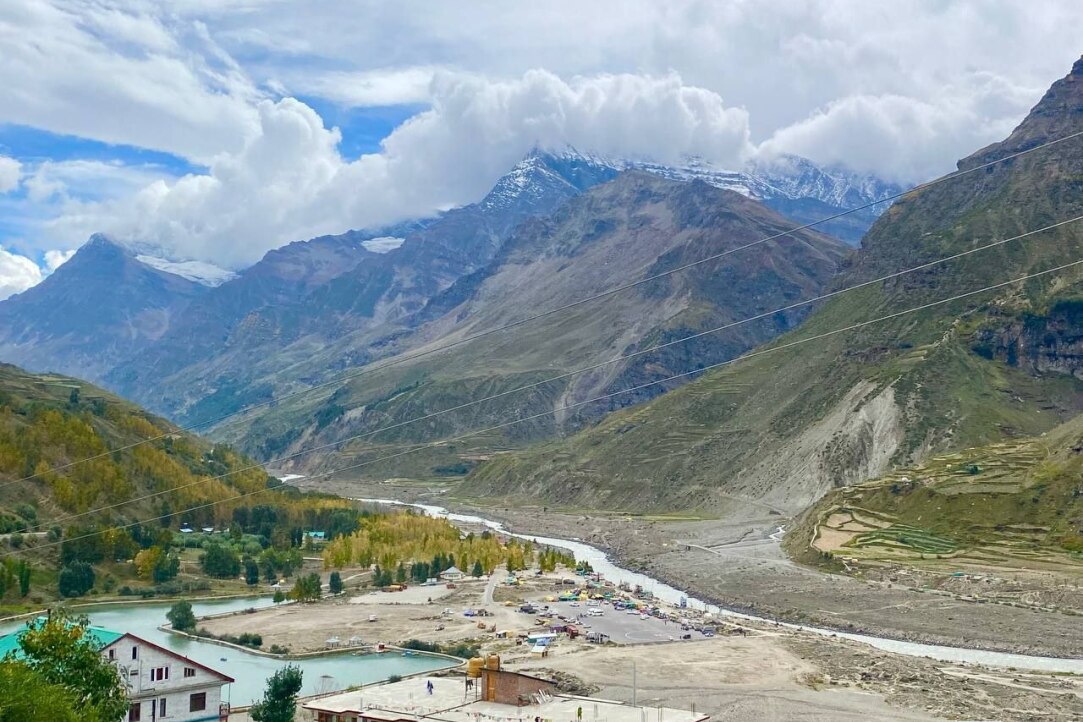Between Natural Risks and Tourism Development: How the Life of Local Communities in the Indian Himalayas Is Changing
In 2024, scientists from HSE University-St Petersburg went on two expeditions to the Indian Himalayas. The second trip finished at the beginning of October, and now, the researchers are summing up its results. Read on to find out what new things they learned about the state of Himachal Pradesh, why floods and earthquakes have increased dramatically, and how local citizens adapt to the growth of tourism in the region.

How the Data Was Collected
The expedition to Himachal Pradesh took place from September 26 to October 2. In seven days, the researchers from HSE University-St Petersburg and the University of Delhi travelled around seven villages of the Lahaul and Spiti district, including Sissu, Tandi, Udaipur, Rubling, Shukto, Urgos, and Jispa. The majority of settlements the researchers visited are located between 3,000 and 3,400 metres above sea level.
The research group included five people from HSE University-St Petersburg: Alexander Sorokin, Dean of the School of Social Sciences, Aleksei Sorbale, Academic Supervisor of the Bachelor's programme 'Political Science and World Politics', Dmitry Omelchenko, Research Fellow of the Centre for Youth Studies, Polina Mironova and Anna Merkulova, students of the Department of Sociology. There were also four employees of the University of Delhi and one PhD student of PGDAV College.
For the fieldwork, they used a qualitative sociological research methodology. 'We opted for it because it was important to immerse ourselves in the life of local communities in the shortest possible time. In-depth interviews and observations are the best suited for these goals. In seven days, we conducted 30 interviews and observed locals working in the field, harvesting, working at schools and medical institutions, and going about their daily lives in general', explains Alexander Sorokin.
'The expedition was my first experience of large-scale sociological fieldwork, and I was really nervous. The interviews helped us to understand the locals' motivations better, their way of thinking and lifestyle,' shares Polina Mironova, second-year student of the Master's in Modern Social Analysis.
The sample included residents of each of the seven villages working in various professional fields—from farmers to hoteliers. The researchers also tried to interview representatives of official and traditional medicine. 'Doctors are well aware of how the health of the citizens is changing, and healers place special emphasis on flora and fauna—they have a special perception of nature, weather and climate, and changes in these things. Without these conversations, we wouldn't even know that among the locals, there are increasing cases of diabetes, heart attacks and other diseases, including mental ones,' explains Alexander Sorokin.
What Caused the Changes
One of the key changes was the construction of a road and the Atal tunnel, which connects the villages of Himachal Pradesh with the rest of the world. Before, these settlements were cut off from the rest of India and even each other. Getting from one village to another took the locals at least two days. Now, they can reach their neighbours by car in two hours. However, the construction not only simplified the transport infrastructure between the cities but also entailed other larger changes—in economics, climate, and even culture.
What Life in Himalayan Villages Is Like
Before the construction of the road, life in the villages of Himachal Pradesh was rather isolated. The locals mostly engaged in agriculture and cattle breeding. Even if they traded, it was mostly with one another. Now, they supply products to other Indian regions and resell them to big companies—for instance, chip manufacturers.
Aleksei Sorbale, Academic Supervisor of the Bachelor's programme 'Political Science and World Politics'

The majority of respondents had several sources of income. For example, elementary school teachers get additional income from selling agricultural produce at local markets, traditional healers from owning holiday homes, and sellers enter into large contracts with representatives of the state food industry. This is a striking contrast to the local citizens of Jammu, where we went on the first expedition. There, the majority of the locals have one source of income: agriculture.
Agricultural technologies have changed as well. The state started to provide the villages with fertilisers and pesticides. Due to this and weather changes, the harvest has become richer and the locals have started to offer more products for sale. New equipment has also appeared, for instance, gasoline-powered cultivators. Nevertheless, residents still use traditional improved 'digging sticks' due to the belief that new technologies do more harm to the land.
There is industrial electricity in large settlements where the road was built. Electronics stores have opened, albeit not chain ones. 'Nomads with iPhones are a common occurrence,' shared Alexander Sorokin. In places where electrical transmission is too expensive, the government installs solar panels. These are enough for the everyday needs and leisure of the locals.
Now, the region is actively developing tourism infrastructure. This is mostly domestic, as foreigners rarely come to Himachal Pradesh. For travellers, cafes are opening and hotels are being built. The buildings themselves also look new—instead of clay and wood, they use cement and brick, more familiar materials and buildings for tourists. Locals also move into new-style houses, though they also see downsides to such constructions.
'Traditional houses were smaller, which means they were easier to heat. These new ones are very cold; there is no heating, and a potbellied stove is not of much use, especially in winter,' explains the dean of the School of Social Sciences.
Alongside tourists, fast food has come to the Himalayan villages and become a common part of daily life. However, local doctors are not happy: the region has had cases of diabetes and heart attacks. Experts link the decline in health with new eating habits.
The local citizens also state that their health is worsening because of litter left by tourists. 'However, we should treat these statements critically,' says Alexander Sorokin. 'There are relatively few tourists, and the locals focus less on their own behaviour and look for reasons elsewhere.'
How the Culture is Changing
Some customs have stayed the same—for instance, rituals related to agriculture. Before the season starts, the villagers hold rituals in hope of a good harvest and organise a festival. In winter, the holidays last months, and residents stay at home or visit each other.
The increase in tourist flow and migration has resulted in a partial loss of local languages. A growing number of young people prefer to speak Hindi or English rather than the local dialect. This makes it easier to move and further integrate in big cities. 'Elderly people blame it on school teachers because they believe the teachers to be the main source of knowledge,' explains Polina Mironova. 'No one takes learning at home seriously.'
What Is Happening to Climate and Nature
In the last 3–5 years, the amount of water in the Himalayan villages has decreased. The locals are scared that in 5–7 years, the water will disappear from these places completely, which means they would have to leave. 'Apart from climate, the water resources were strongly affected by the construction of the tunnel, which radically changed the ecosystem in the Himalayas. Of course, droughts did occur before this, but not as abruptly,' explains Alexander Sorokin.
There are other climate risks: earthquakes, floods and heavy rains have become more frequent. To deal with disasters, the locals install pumps, dig channels, and sometimes hide in shelters. 'During heavy rains, residents of one village went to the mountains and hid in the rocks for two days in a row,' tells the dean of the School of Social Sciences. 'They were scared that the buildings would collapse in the strong wind.'
Alexander Sorokin, Dean of the School of Social Sciences

In the future, we plan to make a map of all the climate changes in the Himalayas. In 2024, there were two expeditions to this region, and two more are scheduled for the future. Apart from that, we and our colleagues from the University of Delhi are discussing the development of a platform on adaptation to climate changes—not only in the Himalayas but in other territories as well. The result might be very interesting. In March 2024, we are planning to prepare a photo exhibition based on the results of the two expeditions as well as present a second documentary film. The first one—Reflection—is ready and will soon be publicly released.

